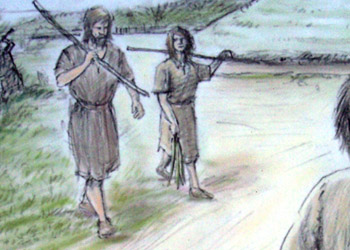Divisioni SS numerate ma di breve esistenza [modifica]
Era già prevista la formazione di altre sette divisioni ed i loro nomi erano già stati assegnati ma a seguito della disfatta e della capitolazione della Germania durarono poco, solo sulla carta.
39. SS-Gebirgsdivision "Andreas Hofer"[23]
Su questa unità si hanno poche notizie, ma sappiamo che il suo impiego bellico avvenne nei territori carsici, tra il Tirolo austriaco, la Slovenia e il Carso. L'organico era costituito da quattro reggimenti (Suedtirol, in seguito ridenominato Bozen, Brixen, Schlanders e Alpenvorland) formati da tirolesi, italiani e sloveni, che ebbero occasione di scontrarsi con formazioni partigiane, soprattutto quelli jugoslavi di Tito, lungo il vecchio confine italo-jugoslavo e, in modo particolare, nel mese di marzo, nella provincia di Gorizia.
L'origine di questo reparto deriva, almeno in parte, dalla "Gebirgsbrigade Alpenvorland", la quale traeva il suo nominativo dalla denominazione assegnata ai territori del Trentino-Alto Adige dopo l'annessione al Reich tedesco avvenuta nel tardo 1943, i cui elementi a loro volta provenivano dalle scuole militari Gebirgsjägerschule der Waffen-SS (Neustift/ Tirol) e SS-Gebirgs-Kampfschule (Predazzo/ Dolomiten).
41. Waffen-Grenadier-Division der SS "Kalevala"[23][24]
Questa unità programmata si sarebbe dovuta costituire, verso la fine della seconda guerra mondiale, usando persone di stirpe ugro-finnica o appartenenti ai Schutzmannschaft (battaglioni di polizia ausiliaria) estoni e livoni.
Il nome "Kalevala" fu scelto prendendo spunto da un poema epico di Elias Lönnrot scritto nella metà dell'Ottocento.
42. SS-Division "Niedersachsen"
43. SS-Division "Reichsmarschall"
44. SS-Division "Wallenstein"
45. SS-Division "Waräger"
Era già prevista la formazione di altre sette divisioni ed i loro nomi erano già stati assegnati ma a seguito della disfatta e della capitolazione della Germania durarono poco, solo sulla carta.
39. SS-Gebirgsdivision "Andreas Hofer"[23]
Su questa unità si hanno poche notizie, ma sappiamo che il suo impiego bellico avvenne nei territori carsici, tra il Tirolo austriaco, la Slovenia e il Carso. L'organico era costituito da quattro reggimenti (Suedtirol, in seguito ridenominato Bozen, Brixen, Schlanders e Alpenvorland) formati da tirolesi, italiani e sloveni, che ebbero occasione di scontrarsi con formazioni partigiane, soprattutto quelli jugoslavi di Tito, lungo il vecchio confine italo-jugoslavo e, in modo particolare, nel mese di marzo, nella provincia di Gorizia.
L'origine di questo reparto deriva, almeno in parte, dalla "Gebirgsbrigade Alpenvorland", la quale traeva il suo nominativo dalla denominazione assegnata ai territori del Trentino-Alto Adige dopo l'annessione al Reich tedesco avvenuta nel tardo 1943, i cui elementi a loro volta provenivano dalle scuole militari Gebirgsjägerschule der Waffen-SS (Neustift/ Tirol) e SS-Gebirgs-Kampfschule (Predazzo/ Dolomiten).
41. Waffen-Grenadier-Division der SS "Kalevala"[23][24]
Questa unità programmata si sarebbe dovuta costituire, verso la fine della seconda guerra mondiale, usando persone di stirpe ugro-finnica o appartenenti ai Schutzmannschaft (battaglioni di polizia ausiliaria) estoni e livoni.
Il nome "Kalevala" fu scelto prendendo spunto da un poema epico di Elias Lönnrot scritto nella metà dell'Ottocento.
42. SS-Division "Niedersachsen"
43. SS-Division "Reichsmarschall"
44. SS-Division "Wallenstein"
45. SS-Division "Waräger"
Altre divisioni SS [modifica]
Mentre, a seguito della disfatta e della capitolazione della Germania, ci furono altre divisioni che furono attivate ma non ebbero assegnate un numero:- SS-Division z.V.
- SS-Grenadier Division "Neu-Turkistan": rimasta sulla carta, al suo posto venne creato l'Osttürkischer Waffen-Verband der SS.
- SS-Kavallerie Division "Kosakken nr. 1"
- SS-Kavallerie Division "Kosakken nr. 2"
- SS-Waffen-Grenadier Division "Rumanische": rimasta sulla carta per la decisione di costituire prima i reggimenti. Vedere volontari rumeni nelle Waffen-SS.
- Waffen-Grenadier Division der SS (bulgarische Nr 1): rimasta sulla carta. Avrebbe dovuto essere costituita a partire dal Waffen-Grenadier Regiment der SS (bulgarisches Nr 1).



